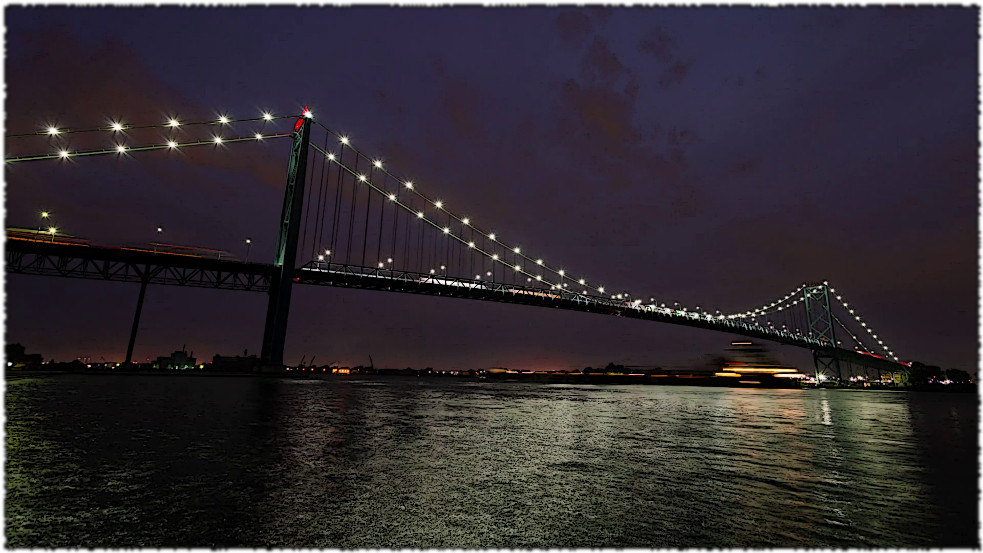Ambassador Bridge
- Detroit ~D~ Palinopsia
Introduction
The Ambassador Bridge (French: Pont Ambassadeur) is a tolled suspension bridge across the Detroit River that connects Detroit, Michigan, United States, with Windsor, Ontario, Canada. It is the busiest international border crossing in North America in terms of trade volume, carrying more than 25% of all merchandise trade between the United States and Canada. A 2004 Border Transportation Partnership study showed that 150,000 jobs in the region and US$13 billion in annual production depend on the Detroit–Windsor international border crossing.
The bridge is owned by Grosse Pointe billionaire Manuel Moroun through the Detroit International Bridge Company in the United States and the Canadian Transit Company in Canada. In 1979, when the previous owners of the bridge put it on the New York Stock Exchange and shares were traded, Moroun was able to buy shares, eventually acquiring the bridge. The bridge carries 60 to 70 percent of commercial truck traffic in the region. Moroun also owns the Ammex Detroit Duty Free Stores at both the bridge and the tunnel.
History
The passage across the Detroit River became an important traffic route following the American Civil War. The Michigan Central and the Great Western railroads in addition to others operated on either side of the border connecting Chicago with the Atlantic Seaboard. To cross the Detroit River, these railroads operated ferries between docks on either side. The ferries lacked the capacity to handle the shipping needs of the railroads, and frequently there were 700–1,000 freight cars waiting to cross the river, with numerous passengers delayed in transit. Warehouses in Chicago were forced to store grain that could not be shipped to eastern markets and foreign goods were stored in eastern warehouses waiting shipment to the western United States. The net effect of these delays increased commodity prices in the country, and both merchants and farmers wanted a solution from the railroads.
The Michigan Central proposed the construction of a tunnel under the river with the support of their counterparts at the Great Western Railway. Construction started in 1871 and continued until ventilating equipment failed the next year; work was soon abandoned. Attention turned in 1873 to the alternative of building a railroad bridge over the river. The U.S. Army Corps of Engineers commissioned a study of a bridge over the Detroit River. Representatives of the shipping industry on the Great Lakes opposed any bridge with piers in the river as a hazard to navigation. Discussions continued for the remainder of the decade to no avail; a bridge over the Detroit River was not approved. The U.S. Congress requested a new study for a bridge in 1889, but no bridge was approved. Finally, the Michigan Central built the Detroit River Tunnel in 1909–10 to carry trains under the river. This tunnel benefited the Michigan Central and Great Western railroads, but the Canada Southern Railway and other lines still preferred a bridge over the river.
Plans for a bridge were revived in 1919 to commemorate the end of World War I and to honor the "youth of Canada and the United States who served in the Great War". The Ambassador Bridge opened November 15, 1929, at a total cost of $23.5 million.
The Suicide Bridge
A Canadian immigration inspector jumped to his death in April 1930, shortly after the bridge opened. The bridge has been used by other suicide jumpers. After it opened, high divers considered it as a venue for a record; but after measurements of the height and currents were taken into account, they were dissuaded and abandoned the attempt.
Design
The bridge over the Detroit River had the longest suspended central span in the world when it was completed in 1929—1,850 feet (560 m). This record held until the George Washington Bridge between New York and New Jersey opened in 1931. The bridge's total length is 7,500 feet (2,286 m). Construction began in 1927 and was completed in 1929. The architect was the McClintic-Marshall Company of Pittsburgh, Pennsylvania.
The bridge is made up of 21,000 short tons (19,000 tonnes) of steel, and the roadway rises as high as 152 feet (46 m) above the Detroit River. Only the main span over the river is supported by suspension cables; the approaches to the main pillars are held up by steel in a cantilever truss structure.
The bridge's only sidewalk is located on the southwest side of the structure. After the September 11 attacks pedestrians and bicycles were formally prohibited from traveling across the bridge due to increased security measures. For years prior to September 11, 2001, the sidewalk was closed due to on-going maintenance projects and repainting.
Originally painted gloss black, the bridge underwent a five-year refurbishment between 1995 and 2000, which included stripping and repainting the bridge teal.
Granite blocks, originally used on the U.S. side, were given to the Windsor Parks and Recreation Department, and now grace many of the pathways in Windsor parks.
Capacity
The Ambassador Bridge is the busiest crossing on the Canada–United States border. The four-lane bridge carries more than 10,000 commercial vehicles on a typical weekday. The Gateway Project, a major redesign of the U.S. plaza completed in July 2009, provides direct access to Interstate 96 (I-96) and I-75 on the American side and Highway 3 on the Canadian side. The Canadian end of the bridge connects to busy city streets in west Windsor, leading to congestion.
The privately owned bridge carries approximately 25% of trade between Canada and the United States.
Sources
https://en.wikipedia.org/wiki/Ambassador_Bridge
